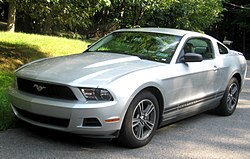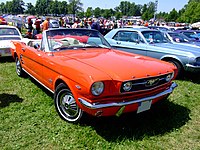MUSTANG!
Készítette: Sass Gyarmati Norbert aki rajongója a mustangnak! itt képtől kezdve minden van!
 A Ford Mustang egy Ford Motor Company által készített személyautó, eredetileg a Ford Falconcompact alapjaira építve, de egy sokkal erősebb izomautó, eredeti nevén pony car. Az első példány Dearborn, Michiganban1964. március 9-én gurult le a futószalagról, nem sokkal később 1964. április 17-én, a New York World's Fair-en csodálhatták meg az érdeklődők. Az Amerikai televíziós hálózatban április 19-én mutatták be. A Goldfinger című James Bond-filmben 1964 szeptemberében láthattuk. Az egész típussorozat meghatározó az autóvilág történelmében. A Mustangból csak az első 18 hónapban több mint egymillió talált gazdára az autószalonokban.
A Ford Mustang egy Ford Motor Company által készített személyautó, eredetileg a Ford Falconcompact alapjaira építve, de egy sokkal erősebb izomautó, eredeti nevén pony car. Az első példány Dearborn, Michiganban1964. március 9-én gurult le a futószalagról, nem sokkal később 1964. április 17-én, a New York World's Fair-en csodálhatták meg az érdeklődők. Az Amerikai televíziós hálózatban április 19-én mutatták be. A Goldfinger című James Bond-filmben 1964 szeptemberében láthattuk. Az egész típussorozat meghatározó az autóvilág történelmében. A Mustangból csak az első 18 hónapban több mint egymillió talált gazdára az autószalonokban.
Az első gondolat a Ford gyártási managerétől (Donald N. Frey) származott [1][2] és megnyerte a Ford általános részlegének vezetőjét, Lee Iacoccat. A Mustang első prototípusa1962-ben készült el, ami egy kétüléses, középkategóriájú (közpes erejű) roadster volt, aerodinamikus orral és alacsony szélvédővel.[3] Ezt egy évvel később, 1963-ban újrarajzolták és négyüléses autóvá alakították. Ez az autó már nagyban megegyezett a később gyártásba került modellel, de ez az autó még ék alakú első lámpákkal, nagyobb hűtőráccsal és nagyobb, akkor először megjelenő hátsó "hasáblámpákkal" rendelkezett, amik szintén a Mustangok jellegzetessége lett, valamint a kocsinak nem voltak lökhárítói.[4]
David Ash és John Oros,[5] a Ford Lincoln–Mercury részlegének stúdiójából amikor készen voltak a "házi" áttervezéssel, felhívták Iacocca-t. Mivel csökkent a vállalat bevétele, a Mustang erősen családias lett, alap összetevőkből építették. Az alváz, a felfüggesztés és a kormány összetevőit nagy részben átvették a Ford Falconból és a Ford Fairlaneből. Az autónak volt egy egységes platform-típus váza, melyet átvettek az 1964-es Falconból, és a hegesztett oldalvázhoz még hozzáhegesztettek 5 kereszterősítőt.
Bár a keménytetős Mustang jól fogyott, merevségi problémák miatt az új keret szokatlan lépéshez vezetett. A kabrió / convertible első megépítésekor biztosítani kellett a megfelelő merevséget. A Mustang és a Falcon (lásd feljebb) hossza azonos volt, de a Mustang tengelytávolsága valamivel rövidebb volt. Teljes szélessége 1732 mm, ennél a Mustang 61 mm-el keskenyebb, de a kerékpálya szinte egyezett. Önsúlya körülbelül 1170 kg hathengeres motorral. A teljes felszereltségű V8 modell 1360 kg-ot nyomott. Bár a mechanikus részek többségét közvetlenül a Falconből vették, a Mustang megjelenése teljesen más volt; sportosabb, rövidebb tengelytávolság, mélyebb ültetés, de magasabb. Az ipar itt alkalmazta először a "torque box"-ot (nyomaték doboz), ami egy olyan innovatív szerkezeti rendszer volt, ami rendkívül merevítette a Mustang szerkezetét és hozzájárult a jobb kezeléshez.
Így néz ki egy Mustang turbo!
Ahogy a fenti kép is mutatja , hasonlít a Daewoo Nexia- ra.
látják?
Tisztára ugyan olyanok!
Most írok egy kis "történetet" a motorjáról:
| Teljesítmény | |
| Motor | 2.800 cm³ Thriftpower I6 3 200 cm³ Thriftpower I6 4 100 cm³ Thriftpower I6 4 300 cm³ Windsor V8 4 700 cm³ Windsor V8 5 000 cm³ Windsor V8 5 000 cm³ Boss 302 V8 5 800 cm³ Windsor V8 5 800 cm³ Cleveland V8 6 400 cm³ FE V8 7 000 cm³ FE V8 7 000 cm³ FE V8 7 000 cm³ Cobra Jet V8 A hengerűrtaltalmak tájékoztató jellegűek |
| Váltó | 3 sebességes kézi 4 sebességes kézi 2 sebességes automata 3 sebességes automata |
| Első generáció | |
egy video a mustangról.
ha egdennel fellenne szerelve ( tuningolva) akkor az ára ::: 423 000 000 euró
egy nagyon jó felni:
a motorról:
Ez már magától egy vagyont ér !
egy mustang szpojler!
 2010 Ford Mustang |
|
| Manufacturer | Ford Motor Company |
|---|---|
| Production | 1964–present |
| Model years | 1965–present |
| Class | Pony car, Muscle car |
| Body style | 2-door 2+2 seat coupe 2-door hatchback/fastback/sportsroof 2-door convertible |
| Layout | FR layout |
Fourth generation (1994–2004)

In 1994 the Mustang underwent its first major redesign in fifteen years. Code-named "SN-95" by the automaker, it was based on an updated version of the rear-wheel drive Fox platform called "Fox-4." The new styling by Patrick Schiavone incorporated several styling cues from earlier Mustangs.[42] For the first time since 1974, a hatchback coupe model was unavailable.
The base model came with a 3.8 OHV V6 (232 cid) engine rated at 145 bhp (108 kW) in 1994 and 1995, or 150 bhp (110 kW) (1996–1998), and was mated to a standard 5-speed manual transmission or optional 4-speed automatic. Though initially used in the 1994 and 1995 Mustang GT, Ford retired the 302 cid pushrod small-block V8 after nearly 30 years of use, replacing it with the newer Modular 4.6 L (281 cid) SOHC V8 in the 1996 Mustang GT. The 4.6 L V8 was initially rated at 215 bhp (160 kW), 1996–1997, but was later increased to 225 bhp (168 kW) in 1998.[43]
For 1999, the Mustang received Ford's New Edge styling theme with sharper contours, larger wheel arches, and creases in its bodywork, but its basic proportions, interior design, and chassis remained the same as the previous model. The Mustang's powertrains were carried over for 1999, but benefited from new improvements. The standard 3.8 L V6 had a new split-port induction system, and was rated at 190 bhp (140 kW) 1999–2004,[44] while the Mustang GT's 4.6 L V8 saw an increase in output to 260 bhp (190 kW) (1999–2004), due to a new head design and other enhancements. There were also three alternate models offered in this generation: the 2001 Bullitt, the 2003 and 2004 Mach 1, as well as the 320 bhp (240 kW) 1999 & 2001,[45][46] and 390 bhp (290 kW) 2003–2004[47] Cobra.
Fifth generation (2005–present)
Ford introduced a redesigned 2005 model year Mustang at the 2004 North American International Auto Show, codenamed "S-197," that was based on the new D2C platform. Developed under the direction of Chief Engineer Hau Thai-Tang and exterior styling designer Sid Ramnarace,[48] the fifth-generation Mustang's styling echoes the shineback Mustangs of the late 1960s. Ford's senior vice president of design, J Mays, called it "retro-futurism." The fifth-generation Mustang is manufactured at the AutoAlliance International plant in Flat Rock, Michigan.
For the 2005 to 2009 production years, the base model was powered by a 210 hp (157 kW) cast-iron block 4.0 L SOHC V6, while the GT used an aluminum block 4.6 L SOHC 3-valve Modular V8 with variable camshaft timing (VCT) that produced 300 hp (224 kW). Base models had a Tremec T-5 5-speed manual transmission with Ford's 5R55S 5-speed automatic being optional. Automatic GTs also featured this transmission, but manual GTs had the Tremec TR-3650 5-speed.[49]
Ford announced in July 2007 that all 2008 Mustangs would have seats containing material derived from soybeans.[50] A new option for the 2009 Mustang was a $1,995 glass roof.[51]
The 2010 model year Mustang was released in the spring of 2009 with a redesigned exterior and a reduced drag coefficient of 4% on base models and 7% on GT models.[52] The engine for base Mustangs remained unchanged, while GTs 4.6 L V8 was revised resulting in 315 hp (235 kW) at 6000 rpm and 325 lb·ft (441 N·m) of torque at 4255 rpm.[53] Other mechanical features included new spring rates and dampers, traction and stability control system standard on all models, and new wheel sizes.
All the Mustang's engines were revised for 2011, and transmission options included the Getrag-Ford MT82 6-speed manual or a 6-speed automatic. Electric power steering replaced the conventional hydraulic version. A new 3.7 L (3.72 L or 227 cu. in.) aluminum block V6 engine shaved 40 lb (18 kg) from the outgoing version. With 24 valves and Twin Independent Variable Cam Timing (TiVCT), it produced 305 hp (227 kW) and 280 lb·ft (380 N·m) of torque. GT models included a 32-valve 5.0 L engine (4951cc or 302.13 cu. in.) (also referred to as the "Coyote" engine) producing 412 hp (307 kW) and 390 lb·ft (530 N·m) of torque on "premium fuel" (91 octane). Power dropped to 402 hp (300 kW) and 377 lb·ft (511 N·m) when using "regular fuel" (87 octane).[54] Brembo brakes are optional along with 19-inch wheels and performance tires.[55] There is much speculation to the actual output of Ford's 5.0 powerplant. Various dynometer tests have revealed that Ford Motor Company underrated the engine, according to the tests the engine is closer to a power of 435 hp and 404 ft. lbs tq.[56]
The Shelby GT500's 5.4 L supercharged V8 block was made of aluminum making it 102 lb (46 kg) lighter than the iron units in previous years. It was rated at 550 hp (410 kW) and 510 lb·ft (690 N·m) of torque.[57]
For 2012, a new Mustang Boss 302, based on the original 1969 model, was introduced. It has an upgraded engine, with a 444 hp (331 kW) and 380 lb·ft (520 N·m) output. It includes stiffer springs and a bigger stabilizer bar at the rear, among other things. Only 3750 Boss 302s will be produced. Most of these are 'regular' Boss 302s, but the other 750 of them will be Mustang Boss 302 Laguna Seca Edition. These extra special editions run about one second faster around Laguna Seca compared to the base Boss 302. The Laguna Seca edition includes a large adjustable splitter in the front, and a X-brace where the rear seats used to be, making it a 2-seater. It also includes R-compound Pirelli Corsa tires, oil, and water temperature gauges. There are also other changes to the Laguna Seca Edition. The package is $6995 more than a base Boss.
The Boss 302 was brought back for the 2013 model year with new colors that included School Bus Yellow, Grabber Blue, and Gotta Have It Green for an additional $395.
In spring 2012, Ford launched an update to the Mustang line as an early 2013 model. The Shelby GT500 has a new 5.8L supercharged V8 producing 662 hp (494 kW) and is capable of speeds upwards of 200 mph. Ford claims it is the most powerful production V8 in the world. The output of the Boss 302 model is unchanged at 444 hp (331 kW) and 380 lb·ft (520 N·m). Both engines are mated to a six speed manual transmission. The GT and V6 models have revised styling that incorporates the grille and air intakes from the 2010-2011 GT500. The GT's 5.0 liter V8 gets a boost of eight horsepower from 412 hp (307 kW) to 420 hp (310 kW), and the V6 remains rated at 305 hp (227 kW) and 280 lb·ft (380 N·m). HID headlights are now standard on all models. New exterior features include an available "pony projection light" which will project a Mustang symbol from the exterior mirrors onto the ground. On the interior, an updated instrument cluster features a 4.2-inch LCD screen positioned between the speedometer and the tachometer. The TrackApps features performance data such as a 0-60 acceleration timer, 1/4 mile timer, 60-0 braking timer, and a G-force monitor, among others. Recaro seats, originally reserved for GT500 and Boss models, are now available as an option in both cloth and leather. Also new for the 2013 model is a SelecShift option on the 6-speed automatic, which allows the driver (via a toggle switch on the gearshift) to select a gear manually and enjoy full control over the transmission.


Honlapkészítés ingyen:
Ez a weblapszerkesztő alkalmas
ingyen weboldal,
ingyen honlap készítés...
Mai: 4
Tegnapi: 38
Heti: 242
Havi: 165
Össz.: 76 649
Látogatottság növelés
MUSTANG! - © 2008 - 2025 - mustangturbo.hupont.hu





